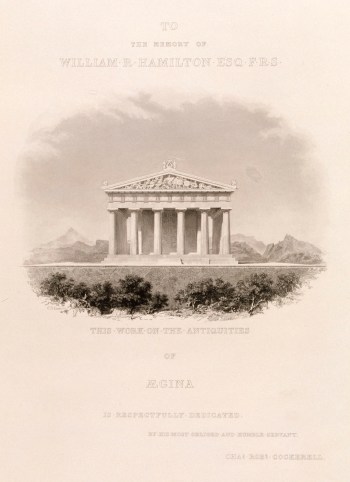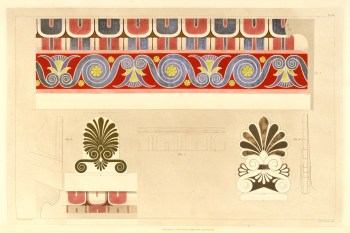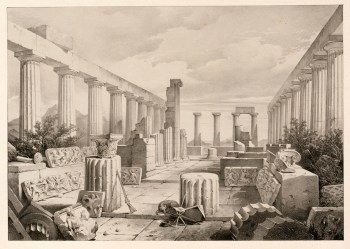The Temples Of Jupiter Panhellenius At Ægina, And Of Apollo Epicurius At Bassæ Near Phigaleia In Arcadia. By C.R. Cockerell, Professor Of Architecture In The Royal Academy, Member Of The Institute Of British Architects, London; Honorary Doctor Of Civil Law, Oxford; Member Of The Dilettanti Society; Associated Member Of The Institute Of France, And Chevalier Of The Legion Of Honour; Member Of The Academy Of St. Luke In Rome; Foreign Member Of The Academies Of Munich, Copenhagen, Geneva, Etc., Etc., Etc. To Which Is Added A Memoir Of The Systems Of Proportion Employed In The Original Design Of These Structures. By William Watkiss Lloyd.
RA Collection: Book
Record number
Author
Imprint
Physical Description
General Note
Contents
Responsibility Note
Most in-text illustrations are unsigned; but the vignette of the first engraved dedication is signed as drawn by C.R. Cockerell and engraved by J. Carter, and the illustration on p. 17 carries the publisher's imprint of John Weale.
The printers' name is given on the title-page verso and in the colophon: 'London: Bradbury And Evans, Printers, Whitefriars.'
The first part of the work is dedicated by Chas. Robt. Cockerell to the memory of William R. Hamilton, Esq., F.R.S.; the second, by C.R. Cockerell to the Society of Dilettanti.
References
Summary Note
The text describes the structure and sculpture (and traces of colour) of the temple of Aphaia (not Jupiter Panhellenius) on the island of Ægina, built shortly after 510 B.C., and those of the temple of Apollo at Bassæ in the Peloponnese, designed by Ictinus, and built ca.429-400 B.C. The latter was built in innovative, transitional style. It includes the earliest known Corinthian capital, unique Ionic columns with flared volutes and bases, engaged columns and an interior frieze. A good overview of all these features is given in the tailpiece on p. 59; and details are displayed in plates 2 (ground plan), 11 (section through the adytum), 12 (longitudinal section), 13 (the Ionic order), 15 (the Corinthian capital). The frieze from Bassæ was bought by the Prince Regent (afterwards George IV) for the British Museum, and the Aiginetan marbles by Ludwig I for the Glyptothek in Munich.
The plates are engravings, lithographs or aquatint. Some are hand-coloured (first sequence nos. 6bis, 7, 9); one is a photograph (between pl. 15 and 16).
Provenance
Name as Subject
Subject
British - Archaeology - Archaeologists - Greece - History - 19th century
Art history - Plans - Elevations - Sections - Views - Great Britain - 19th century
Pictorial works - Lithographs - Aquatints - Hand coloring - Great Britain - 19th century
Contributors
John Weale, publisher
C.R. Cockerell RA, draughtsman, previous owner, donor
Robert Brandard, engraver
J.M.W. Turner RA, draughtsman
Edmund Turrell, engraver
Rosenberg, engraver
W. D. Taylor, engraver
James Carter, engraver
William Richard Hamilton, dedicatee
Bradbury and Evans (London), printer
Day and Son, lithographer
Society of Dilettanti (London), dedicatee
Images from this book
18 results
-

C.R. Cockerell RA
Temple of Apollo Epikourios, Bassae: section, 1860
Etching
-

C.R. Cockerell RA
Temple of Aphaia, Aegina, 1860
Etching and engraving
-

C.R. Cockerell RA
Temple of Aphaia, Aegina: western acroterium, 1860
Etching and engraving
-

C.R. Cockerell RA
Temple of Aphaia, Aegina: portion of the eastern front, 1860
Etching and aquatint with hand-colouring
-

C.R. Cockerell RA
Temple of Aphaia, Aegina: exterior orders, 1860
Etching and aquatint with hand-colouring
-

C.R. Cockerell RA
Temple of Aphaia, Aegina: details of painted and gilded ornament, 1860
Etching and aquatint with hand-colouring in watercolour, gouache and gold paint
-

C.R. Cockerell RA
Temple of Aphaia, Aegina: tiling of the roof, 1860
Etching and aquatint
-

C.R. Cockerell RA
Temple of Aphaia, Aegina: The Fallen Laomedon, 1860
Etching and engraving (on steel?)
-

C.R. Cockerell RA
Temple of Apollo Epikourios, Bassae: longitudinal section, 1860
Etching
-

C.R. Cockerell RA
Temple of Apollo Epikourios, Bassae: view from Paulitza, 1860
Etching
-

C.R. Cockerell RA
Temple of Apollo Epikourios, Bassae: the interior after excavation, 1860
Chalk lithograph
-

C.R. Cockerell RA
Temple of Minerva, Port of Aegina, 1860
Etching and aquatint (on steel?)
-

C.R. Cockerell RA
Temple of Apollo Epikourios, Bassae: view of the ruins from the north, 1860
Chalk lithograph
-

C.R. Cockerell RA
Temple of Apollo Epikourios, Bassae: north front, 1860
Etching
-

C.R. Cockerell RA
Temple of Apollo Epikourios, Bassae: details of isolated column in interior, 1860
Etching
-

C.R. Cockerell RA
Temple of Apollo Epikourios, Bassae: view of interior, 1860
Etching and engraving (on steel?)
-

C.R. Cockerell RA
Temple of Aphaia, Aegina: longitudinal section of platform and cave, 1860
Etching and engraving (on steel?)
-

C.R. Cockerell RA
Temple of Aphaia, Aegina: view from the east, 1860
Etching and aquatint (on steel?)

















